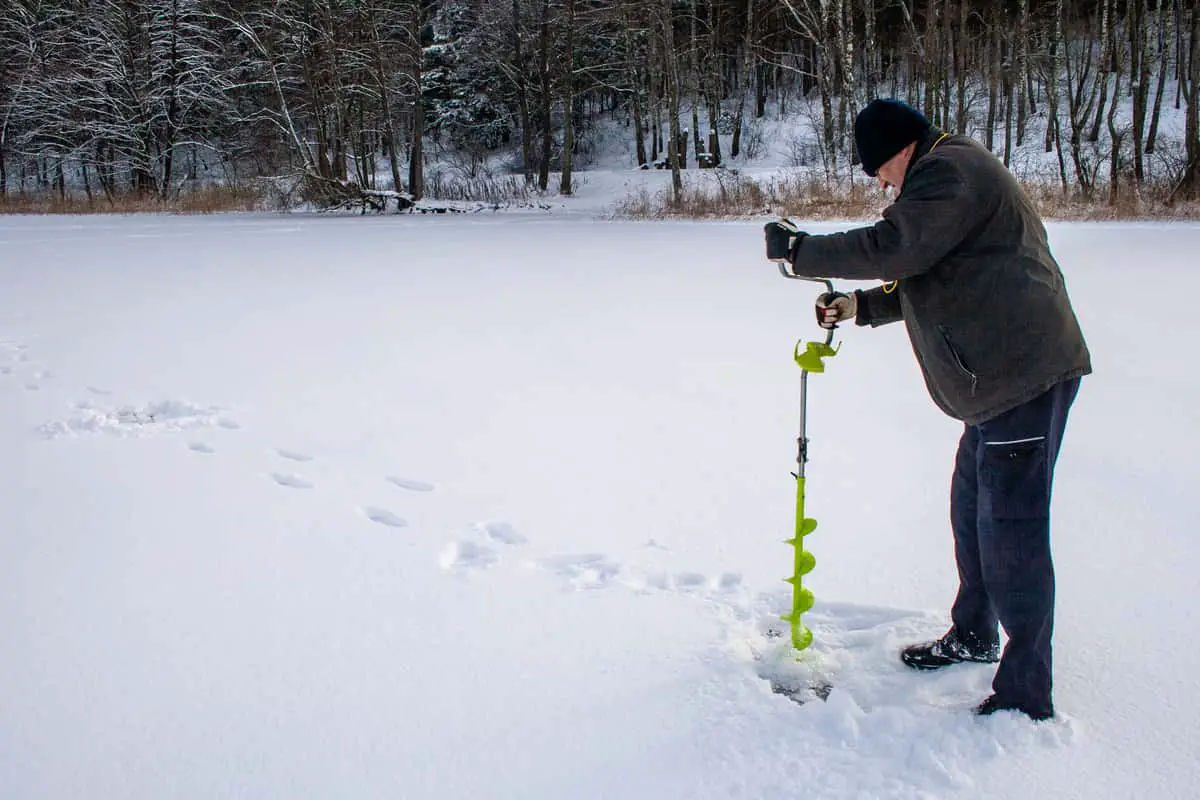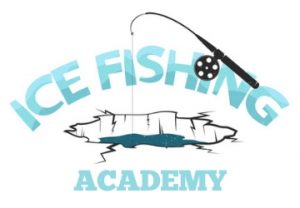This post contains affiliate links.
You’d be surprised at how inexpensive it is to go ice fishing when you’re just starting out! There isn’t that much equipment needed to get out on your local city lake neighborhood pond! It’s when you begin to upgrade your equipment the costs start to rise! Here’s what it costs to go ice fishing!
For slightly less than $100, you can begin ice fishing and catching panfish, walleye, or trout in your local waters with the essential winter ice fishing gear. Consisting of a hand auger, safety ice picks, a rod and reel combo, and a 5-gallon bucket to sit on and place your catch in.
It doesn’t take much money or a huge investment to start ice fishing your local ponds and lakes to begin with. My first ice fishing attempt was in southeast Kansas, and I used a Stihl Work Boss chainsaw to cut a square hole in the ice to fish through!
My “ice fishing rod” was a 7′ Medium Heavy bass jigging rod, and I was standing over a square hole about 6′ from a dock extending out into a local county lake!
You can get into ice fishing for very little money, or you can end up spending a lot of cash once you start getting serious about fishing through the ice! Read on and decide for yourself!
Is Ice Fishing Expensive?
Ice fishing is one of the least expensive fishing activities to get started in. It can also be one of the most expensive if you decide to upgrade to expensive electronics, underwater cameras, and shelters!

Ice fishing can become expensive if you purchase additional equipment to fish seriously. An ice shelter can cost $200 to $700+. The price of an electric auger runs $400+. An ice fishing flasher will cost $250 to $700, and an underwater camera can add another $1,000! Although you can still ice fish for under $100!
As you become older or want to venture further from shore, you may decide to purchase a four-wheeler, ATV, side-by-side, or a snowmobile to access areas on snow-covered lakes! Puchasing additional gear or transportation will increase the costs associated with ice fishing quite a bit!
To fish locally near your town or city, it doesn’t take much fishing gear to have a lot of fun! If you don’t have any ice fishing gear, you can certainly get started with the basic fishing equipment for less than $100. Maybe more, maybe less depending on your area and how basic you want to go.
What Equipment Do I Need for Ice Fishing
The basic equipment you’re going to need to have a good day on the ice, outside of your winter clothing would consist of a way to cut a hole into the ice, your fishing equipment (rod & reel, tackle, bait, etc.), and above all else safety gear!
I would start with the following because this is what I pretty much began with when I started to get serious about ice fishing!
- Spud Bar or Hand Auger
- Fishing Rod & Reel Combo
- Tackle, Jigs & Spoons
- Safety Ice Picks
- 5 Gallon Bucket
Spud Bar or Hand Ice Auger
In early winter, with what we call “Early Ice,” this is probably one of the hottest bites of the ice fishing season except for “Late Ice.” Being the ice is only a few inches thick, it’s pretty easy to cut a hole through it.
A spud bar is a heavy ice chisel that can range in length from 19″ (bucket chisel) to 5 feet long. It has a sharpened blade or chisel point on one end and is used with a fast downward motion to chip or cut through the ice. The weight of the spud bar carries enough force to drive it into the ice.
With a spud bar or ice chisel, I can easily chip a hole through 3 to 4 inches of ice in a few minutes. Thicker ice takes quite a bit more time and depending upon the ice’s thickness, and you’ll need to remove the ice chips from the hole every so often.
Another great reason to have an ice spud bar is for safety reasons! With early ice, you will want to use the heavier spud bar to “test” the ice as you walk out onto it. You do this by spearing the ice three or four times just ahead of each step you take.
If the spud bar goes through the ice or water begins to seep up through the hole, you can determine the ice isn’t safe enough to walk on any further. Wait a few more cold days for the ice to thicken up!
Once the ice gets beyond 5 to 6 inches thick, I prefer to use an hand auger.
Hand ice augers come in different size diameters. With the most common diameter sizes being 4″, 6″, and 8″. They will each easily cut through early ice. Once the ice reaches 8″ and thicker, the smaller diameter holes are easier to cut with since they cut a smaller section of ice.

After the ice reaches a thickness of 8 to 10 inches or more, using the larger diameter hand augers become very tiresome to cut a number of holes. For most city lakes and ponds that hold panfish and trout, a 4″ auger will suffice if you plan on moving around a lot.
Fishing Rod & Reel Combo
Of course you will need an ice rod and a good fishing reel!
Choose a rod/reel combo with at least four guides (including the tip-top), and five guides are even better. More guides will allow the fishing line to follow the “curve of the rod” when you fight a fish.
There are plenty of good ice fishing combos to choose from which won’t break the bank.
The Berkley Cherrywood Ice Fishing Spinning Combo on Amazon is a terrific rod and reel combo to begin your ice fishing adventures! Personally, it’s probably one of the least expensive combos that I would go with!
For the next step up in quality, I would choose the 13 FISHING – Thermo Ice Combo. It has a good, solid reel, and the rod handles nicely too!
I can spend quite a bit on rods and reels, but I would suggest starting with something not as expensive until you decide you enjoy the sport and want to upgrade to better equipment.
Tackle, Jigs & Spoons
An assortment of terminal tackle such as snap swivels, split shot weights, and small spoons and jigs will round out a mini tackle box you can slip into your pocket!
Some many companies and manufacturers produce outstanding jigs and spoons that have caught thousands of fish over the years. Usually, there is a favorite lure and bait that the locals like to use in a locale. Ask for advice in your local bait shop!
Some of my favorite jigs are the Dave Genz Drop Kick Jig and Leech Flutter Spoons from Clam Outdoors.
You can find a wide assortment of ice fishing jigs and spoons at your local bait and tackle store (my preferred place to shop) or Walmart has stores everywhere too.
Safety Ice Picks
What are safety ice picks?
Safety ice picks are handheld safety devices with sharpened spikes in each handle. They are attached with a length of cord or coiled lanyard. For safety reasons, ice picks are worn around your neck while ice fishing and used to extract yourself from the water if you fall through the ice.
If you happen to fall through some thin ice, you can use the Frabill Retractable Ice Picks to give you a secure hold on the ice to pull yourself out.
Having safety ice picks with you and is a place where you can easily reach them is the single most important item you can have with you!
I’ve never had to use them yet in thirty years, and I always use a spud bar to check the ice while walking out!
5 Gallon Bucket
Everyone has a 5 gallon bucket lying around, ot you can pick one up at your local Home Depot, Menards, or Lowes store!
The bucket is handy to have all your gear in while you walk out to your fishing hole. With the bucket in one hand, you can easily use the spud bar to make sure the ice is safe to continue walking out on.
Once you have your hole drilled, simply turn the bucket over and use it for a seat, and you can place the fish you catch in the bucket to walk back to the shore when you’re done!
Buying Used Ice Fishing Equipment
By comparison shopping locally, you should be able to purchase all your basic equipment to get out onto the ice for $100.00 or even less if you are a savvy shopper!
What I would recommend is to watch your local Facebook pages. Almost every State with ice fishing has a local buy/sell page, and you can find great deals on whole ice fishing packages a lot of the time!
I sell on Facebook quite often and will also find good deals on fishing electronics (savings of 50% or more) and will purchase them for resale or to have as a backup unit to my own.
New gear is often expensive and if you don’t mind something that is slightly used, search the classifieds, Facebook, or watch for local neighborhood garage sales!
Have fun and stay safe out there!


